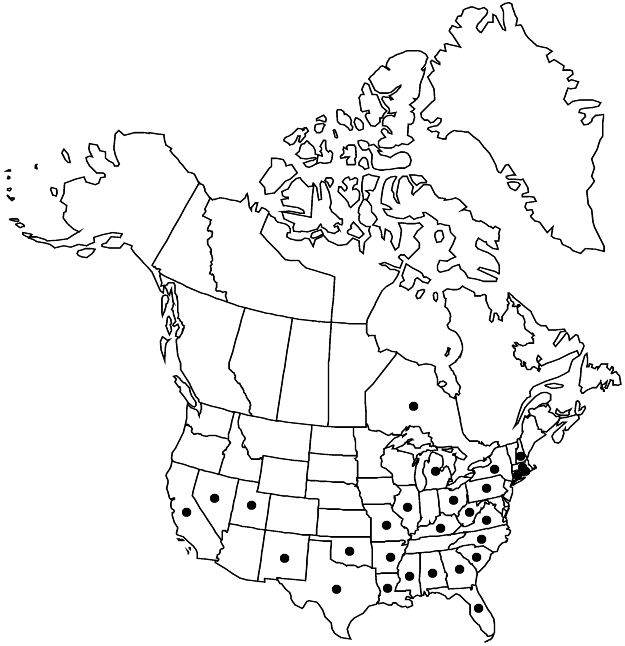Difference between revisions of "Cucumis melo subsp. melo"
FNA>Volume Importer |
imported>Volume Importer |
||
| (5 intermediate revisions by 2 users not shown) | |||
| Line 19: | Line 19: | ||
|elevation=20–300 m | |elevation=20–300 m | ||
|distribution=Ont.;Ala.;Ark.;Calif.;Conn.;Fla.;Ga.;Ill.;Ky.;La.;Mass.;Mich.;Miss.;Mo.;Nev.;N.H.;N.Mex.;N.Y.;N.C.;Ohio;Okla.;Pa.;R.I.;S.C.;Tex.;Utah;Va.;W.Va.;w Asia;w Africa;introduced also in West Indies. | |distribution=Ont.;Ala.;Ark.;Calif.;Conn.;Fla.;Ga.;Ill.;Ky.;La.;Mass.;Mich.;Miss.;Mo.;Nev.;N.H.;N.Mex.;N.Y.;N.C.;Ohio;Okla.;Pa.;R.I.;S.C.;Tex.;Utah;Va.;W.Va.;w Asia;w Africa;introduced also in West Indies. | ||
| + | |introduced=true | ||
|discussion=<p>Plants of <i></i>subsp.<i> melo</i> outside of cultivation in the flora area mostly are the dessert melons; var. cantalupo and var. inodorus.</p><!-- | |discussion=<p>Plants of <i></i>subsp.<i> melo</i> outside of cultivation in the flora area mostly are the dessert melons; var. cantalupo and var. inodorus.</p><!-- | ||
--><p>Main cultivar groups of <i></i>subsp.<i> melo</i>:</p><!-- | --><p>Main cultivar groups of <i></i>subsp.<i> melo</i>:</p><!-- | ||
| Line 32: | Line 33: | ||
-->{{#Taxon: | -->{{#Taxon: | ||
name=Cucumis melo subsp. melo | name=Cucumis melo subsp. melo | ||
| − | |||
|authority=[I] | |authority=[I] | ||
|rank=subspecies | |rank=subspecies | ||
| Line 48: | Line 48: | ||
|publication year= | |publication year= | ||
|special status= | |special status= | ||
| − | |source xml=https:// | + | |source xml=https://bitbucket.org/aafc-mbb/fna-data-curation/src/2e0870ddd59836b60bcf96646a41e87ea5a5943a/coarse_grained_fna_xml/V6/V6_54.xml |
|genus=Cucumis | |genus=Cucumis | ||
|species=Cucumis melo | |species=Cucumis melo | ||
Latest revision as of 22:21, 5 November 2020
Plants andromonoecious. Stems glabrous or sparsely villous. Hypanthia pilose to lanate, hairs spreading. Pepos edible, broadly ellipsoid to subglobose, 10–20+ cm diam., rind tan, yellowish, lemon yellow, light yellowish green, dark green, or light orange, smooth, ridged, netted, warty, or scaly; flesh orange to yellowish or green, juicy, sweet.
Phenology: Flowering Jul–Oct.
Habitat: Gardens, fields, field edges, trash heaps, garbage dumps, lake shores, roadsides, ballast, sometimes volunteering from past plantings
Elevation: 20–300 m
Distribution

Introduced; Ont., Ala., Ark., Calif., Conn., Fla., Ga., Ill., Ky., La., Mass., Mich., Miss., Mo., Nev., N.H., N.Mex., N.Y., N.C., Ohio, Okla., Pa., R.I., S.C., Tex., Utah, Va., W.Va., w Asia, w Africa, introduced also in West Indies.
Discussion
Plants of subsp. melo outside of cultivation in the flora area mostly are the dessert melons; var. cantalupo and var. inodorus.
Main cultivar groups of subsp. melo:
a. Cucumis melo var. cantalupo Seringe. Asia; pepos medium-large, rind smooth, scaly, or netted, variable in color, aromatic with sweet, juicy flesh, dessert melons; andromonoecious. Formally a nomenclatural synonym of C. melo var. melo; the name var. cantalupo Seringe predates var. cantalupensis Naudin, which is often used for this dessert melon.
b. Cucumis melo var. inodorus Jacquin. Europe (Spain), Asia; pepos large, winter melons, with non-aromatic, non-climacteric and long-storing fruits, rind thick, smooth, wrinkled, or warty, dessert melons (honeydew, winter melon); andromonoecious.
c. Cucumis melo var. melo. Asia, Africa; pepos large, flesh sweet, rind netted, warty, or scaly, wild form of dessert melons; andromonoecious.
Selected References
None.